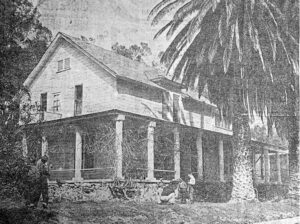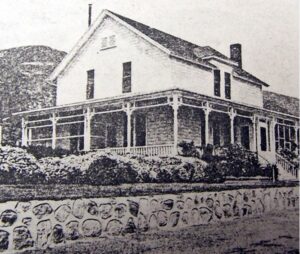by Alice Hall
Before John A. Devore, many settlers claimed land in and around the hills where Devore now nestles. Those settlers were why the U.S. Government did not push their dispute against Henry Hancock over the conflict of interests shown when he surveyed the Muscupiabe Rancho. The government didn’t want to disrupt those many lives.
Besides Cole, other settlers in the area at the time were: Moses Sweat, a gold miner who owned his home; Narcisso Baroni, an irrigator, and his family; Refugio Chavia of the Cahuilla Tribe, who owned his own home where he housed his family; Peter Pahl, a German doctor, and his wife Harriet; Frank Coa, a servant and a teamster; Amanda Gavits, a Canadian nurse; Leon Lason or Lacon, a prospector from Virginia. People with their own farms were: McNew, Meyer, Long, Clark, Davidson, Riedel, Bledsoe, Bemis, Martin, and Leach. Other settlers in the area were Taylor, Van Horn, and Huey. Douglas was near Cole.
THE AKERS
The Akers were important settlers in the 1800s. Larkin B. Akers sold for $500 to John Akers in 1883, all his land, easements, and water rights in and around Akers Canyon in Section 21 of Township 2N, Range 5W, San Bernardino Meridian. Akers Canyon was described as being due north of the Old Martin Station (Glen Helen). That would make it Kimbark and put it in the vicinity of the alfalfa field the Coles later sold to Devore and Marble. The Coles may have had ownership as early as 1891.
In 1884, John M. Akers sold for $500 all his land in and around Akers and Alder canyons (the two Kimbarks?) to Henry De Garmo, John Hauser, and M.D. Katz.
In 1886, John M. Akers sold for $1000 to T.B. Lyon 80 acres of the John M. Akers place in Section 28 at the mouth of Cajon Pass. Neighbors mentioned as having previously bought land in Section 28 from John M. Akers were Bart Smithson to the east and M. Phelps to the west.
In 1886, L.B. Akers sold back to John Hancock, the owner of Rancho Muscupiabe and brother of land manager and surveyor Henry Hancock, land and water rights to Akers Creek he had purchased from Hancock three years before. The resale price was $1350 in gold coin.
L.B. Akers was also the father of Julia, who married Henry Hopper at the age of 16 in 1873. They settled in Section 22 of Devore, raised several children, and bought additional land from Devore early in his short tenure.
The Hopper place was on the top side of Foothill just west of Deercrest. Hopper Canyon still bears that name, and one of the Hopper sons has returned to see his birthplace through the years. During two of those visits, he spoke with Nancy Sneed, as the Sneed home is at Hopper Canyon.
THE DEVORES—1901
THE DEVORES
John A. Devore was born in Pennsylvania in 1859 to parents who had also both been born in PA according to the 1880 US Census in Cook County, IL.
At the time he was 22, he lived with Daniel and Martha Evans, his in-laws, his wife Anna, age 21, herbrother Walter age 20, a 23-year-old book keeper named James Seaton from England and a 19-year-old Swedish maid named Ida Olson. Daniel and Walter Evans were both listed as bakers. Martha and Anna were named as homemakers, but no job was mentioned for John A. Devore.
In 1890, John and Anna Devore and Walter Evans, all who lived at 3235 Rhodes Ave., were listed in the Chicago Blue Book of Selected Names.
Somewhere along the line Devore acquired a high-ranking position in Kenwood Corporation, a clothing manufacturer specializing in railroad uniforms. Apparently that business sent him to California at the age of 42, where his dealings with the railroads and his willingness to help the corporation develop the land they had acquired gave him a modicum of fame.
John Devore’s vision for the land that now bears his name was evidently for a place of grace and beauty, and authors of his time lauded him for the lovely homes, rock walls, and gardens he had incorporated into the design of the community.
Perhaps Kenwood, the upscale section of Chicago where Anna’s family lived, influenced his plans.
According to friends mentioned in his obituary, he had many more plans for Devore that never materialized, one of which may have been a golf course. By the time he was 45 he was in poor health and looked forward to days of better vitality so he could accomplish those plans. Unfortunately, he had a paralyzing stroke at the age of 48 and died shortly thereafter. Whatever dreams he had for the village named after him remain unknown.
Anna remarried, mortgaged the property John had quitclaimed to her, and lost all of it within three years.
When John Devore died, his widow had to dispose of 14 horses, a Jersey cow, eight carriages/buggies, 11 plows, four mowers, two rakes and various other tools, a six-ton Fairbanks scale, 12 picking boxes, 18,000 trays, 700 sweat boxes, and all kinds of furniture and other equipment, including a gas manufacturing plant for illumination.
THE DEVORE HOUSE
The Optimist Boys’ Ranch was home to needy boys for decades, and it was a great place for some local young people to find good work, too.
It originally opened in 1951, but was closed for over a decade after the Devore House burned down. It reopened in 1980 when the new house was constructed, but it did not reopen without opposition from the Committee for Devore.
The Optimists said they would be taking boys who were truants, incorrigibles, runaways, petty thieves, and those whose families had given up.
Not welcome in the home would be boys who were arsonists, rapists, assaulters, and serious druggies.
Optimists said they wanted to teach the boys to respect their community, and they appreciated the fact that in Devore 4-H clubs still flourished and children were taught to love the land. The property was sold to a developer in 2006.

Picture 1—The Devore House was built in 1900 by John Devore on his 1800 acre ranch that became the community that bears his name. From a Sun photo, 1950s.
It served as a stage station.
Devore died in 1907, and in 1912 his widow sold the house to R.B. Peters, who lived in it until 1928.
It became Paige Military Academy, Devore Sunday School, and Optimist Boys Ranch.
It stood at the corner of Muriel and Kimbark.
(Sun Photo and caption from the ’50s found in The California Room at the Feldheym Library).

Picture 2—The Devore house in 1908 after John A. Devore’s death, and Anna Devore lived in the house. According to some sources, Mrs. R.K. Walker lived in the house at the time it was sold to Peters.
Photo from the Sun Souvenir Number of 1908, thanks to The California Room at the Feldheym Library.
The porch pillars and rails certainly changed.